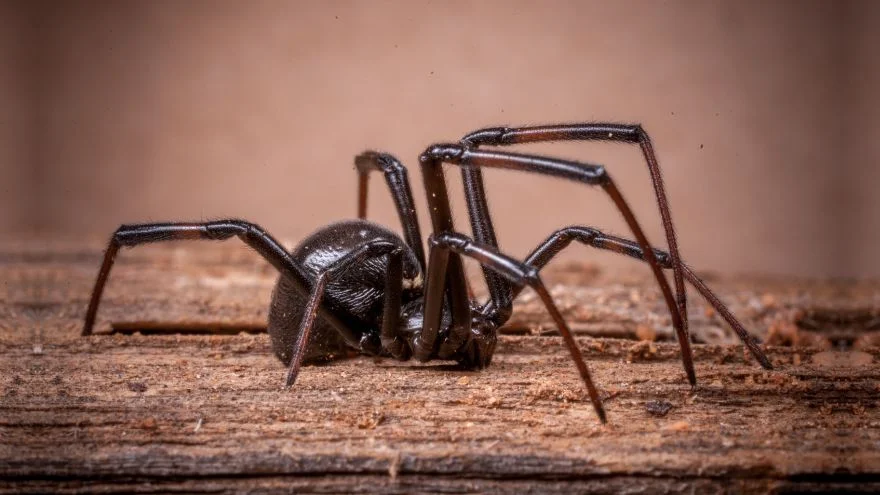Nebraska is renowned for its striking beauty and stunning landscapes.
From the rich soils of the panhandle to the Sandhills in the north and the national forests, they form principal habitats where much lovely wildlife thrives.
While Nebraska is renowned for harboring amazing and adorable animals, not all these animals are lovely and harmless. Some of the deadliest and most dangerous animals in Nebraska include American black bears, poisonous spiders, venomous snakes, etc.
This article will review 12 of the most dangerous animals you should avoid while in Nebraska and safety tips for exploring the wildlife in the area.
What are the Most Dangerous Animals in Nebraska
1. American Black Bear

- Scientific name: Ursus americanus
- Classification: Mammal
- Habitat: Woodlands, forests
- Diet: Omnivorous
- Conservation status: Least concern
The black bear is a large mammal commonly found in North America’s forests.
They are sometimes called the cinnamon bear, the blue-black glacier bear, or the brown bear and vary in color even within the same litter.
Bears though docile, are dangerous. If provoked, they can become hostile, which can sometimes be fatal.
In 2019, a 39-year-old Colorado woman was involved in a fatal Black Bear attack, which unfortunately led to her death.
Attacks by bears on humans occur, although it is rare. The few who have been able to survive a black bear attack have often described their experience as traumatic.
Another report featured a 12-year-old victim who recounted her ordeal, which she describes as a traumatic near-death experience.
Also, residing in an area where bears roam increases the risk of an attack as bears could sometimes become territorial.
2. Coyotes
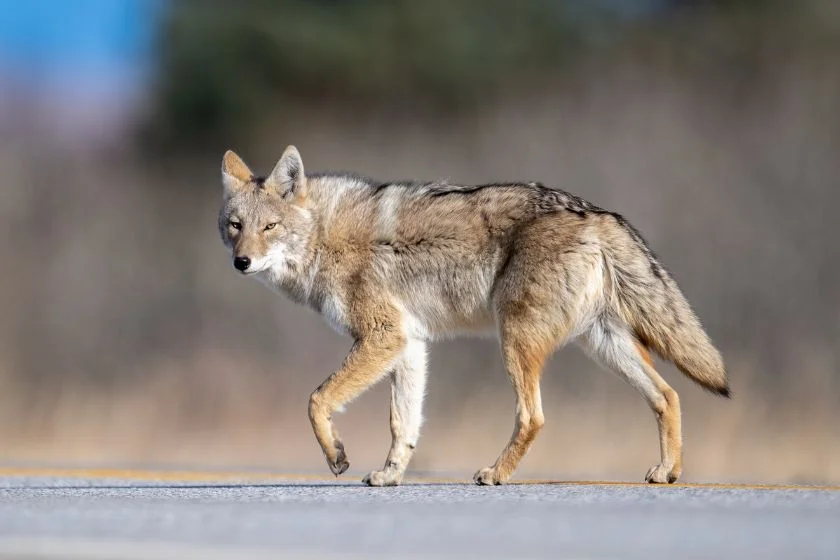
- Scientific name: Canis latrans
- Classification: Mammal
- Habitat: Mountains, forests, plains
- Diet: Carnivores
- Conservation status: Least concern
Coyotes are canine species and are native to North America.
They are also called the prairie wolf or the brush wolf as they are close relatives of the wolves but are quite smaller.
They regulate their body temperature by panting heavily, just like dogs.
They are dangerous because they do not fear humans; they also attack livestock, causing economic loss.
The Urban Coyote Research puts the number of reported Coyote attacks in the US and Canada at 142, resulting in 159 fatalities between 1960–2006.
However rare these figures may seem, please stay away from them because they can bite you when hungry.
According to the National Center for Biotechnology Information (NCBI), a coyote bite can infect you with rabies and other deadly diseases.
3. Copperheads

- Scientific name: Agkistrodon Contortrix
- Classification: Reptilia
- Habitat: Hillsides
- Diet: Carnivores
- Conservation status: Not Threatened
Copperhead snakes are one of the various poisonous snakes in Nebraska.
Unlike other snakes, such as the rattlesnake, they hardly make their presence known, which makes them dangerous.
They have a heat-sensing pit on their face that helps to detect prey.
They usually bite when they are stepped on as they are usually mistaken for leaves; therefore, always be cautious of where you step in Nebraska.
Try not to attack them; they usually strike when they are threatened.
4. Black Widow Spider

- Scientific name: Latrodectus mactans
- Classification: Arachnid
- Habitat: Rock piles, rodent burrows, hollow tree stumps
- Diet: Carnivore
- Conservation status: Least Concern
The black widow is also called the shoe-button spider.
They usually thrive in temperate habitats but can also be found on all continents apart from Antarctica. Nebraska contains several black widow spiders.
Victims who this venomous insect has bitten have shared their horrific experiences, and you don’t want to be one of the statistics.
The black widow spider’s bite usually feels like a needle pick. Sometimes victims don’t feel anything until 15 to 30 minutes before the venom attacks the nervous system.
Symptoms such as muscle spasms, intense pain, vomiting, etc., follow afterward.
The Black Widow Spider is reported to possess a very lethal poison, and its poison is 15 times stronger than the rattlesnake venom.
They hardly sting unless they feel threatened or are trapped. Moreover, it is only the females that sting. The males don’t sting. After mating, the female black widow often feasts on the male.
Reports show that around 7 to 8 people die from the black widow spider bite annually in the United States.
5. Timber Rattlesnake
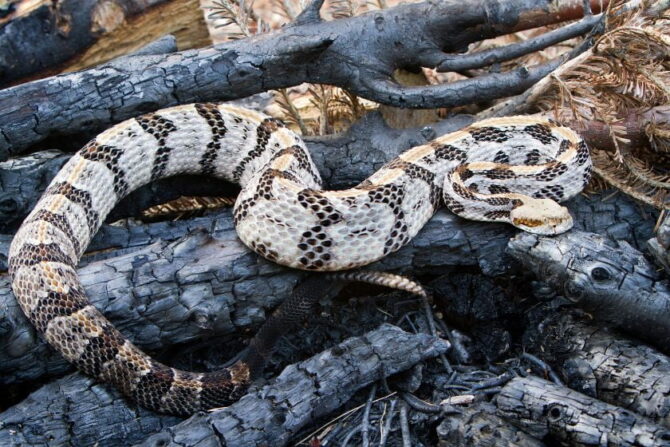
- Scientific name: Crotalus horridus
- Classification: Reptile
- Habitat: Swamps, pine forests, hilly forests
- Diet: Carnivorous
- Conservation status: Least concern
Timber rattlesnakes, also known as the American viper or the cane-brake, occupy many regions in Nebraska. These pit vipers have varying colorations and are huge.
They are one of the most dangerous snakes in North America due to their huge size and highly potent venom capable of causing the loss of human lives.
When a timber rattlesnake perceives a threat, it rattles its tail as a warning before striking.
6. Brown Recluse
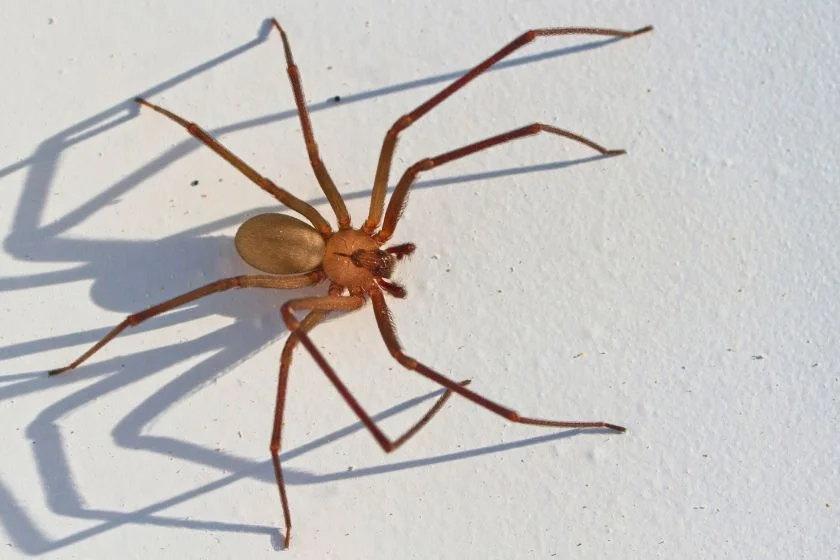
- Scientific name: Loxosceles reclusa
- Classification: Arachnid
- Habitat: Woodpiles, garages, closets, tree barks
- Diet: Carnivorous
- Conservation status: Least concern
This spider is native to many regions in the United States.
They have violin-shaped markings on their body; because of that, they are called the fiddlebacks.
They are brown-colored spiders with varying shades.
They are masters of hiding and prefer to stay away from humans; however, they are still dangerous, as their venom contains toxins that can cause nausea, skin damage, and muscle pain.
Seeking medical help is advised should you get bitten.
7. Massasauga
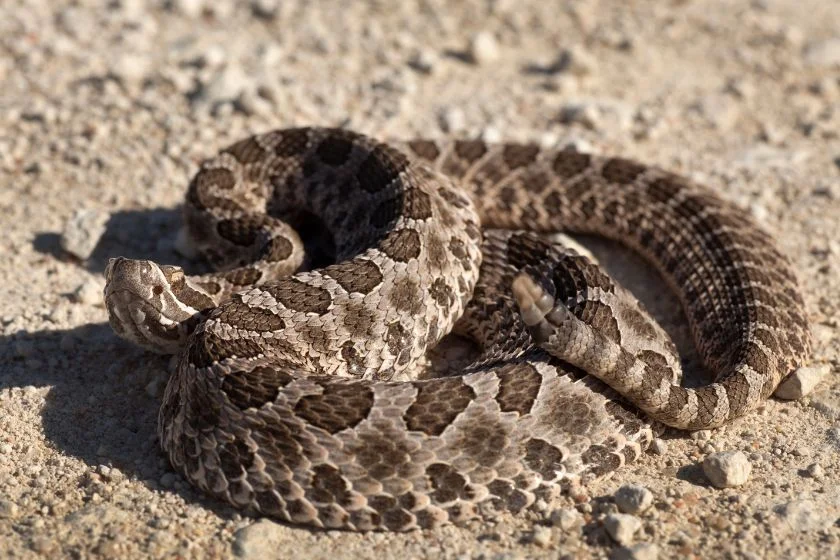
- Scientific name: Sistrurus catenatus
- Classification: Reptile
- Habitat: Woodlands, grassland, Rocky areas
- Diet: Carnivore
- Conservation status: Least concern
The Massasauga is a rattlesnake species and a pit viper common in Midwestern North America.
It is a venomous snake whose color pattern consists of a grey color with brown or black blotches.
There are three recognized sub-species of this snake.
The massasauga is very dangerous because its venom is cytotoxic; capable of damaging living tissues.
However, this reptile tends to avoid humans due to its shy nature.
Most bites from the massasauga are caused by people trying to handle it or accidentally stepping on it.
8. Prairie Rattlesnake

- Scientific name: Crotalus viridis
- Classification: Reptile
- Habitat: Rocky mountains, caves, vegetation covers
- Diet: Carnivore
- Conservation status: Least Concern
The prairie rattlesnake is also called the great plains rattlesnake, and it is native to North America.
It has an intranasal scale with a rectangular head. On each side of its head are heat-sensing pits.
The venom of the Prairie rattlesnake can destroy living tissues due to its neurotoxic nature.
When it perceives a threat or when injured, it automatically strikes. It typically vibrates its tail to produce a rattling sound to ward off intruders.
9. Mosquitoes

- Scientific name: Culicidae
- Classification: Insect
- Habitat: Forest, mashes, tall grass
- Diet: Parasite
- Conservation: Least concern
Mosquitoes’ buzzes are annoying and discomforting. These insects with segmented bodies, a pair of wings, and an elongated sharp mouth have their life cycle consisting of the egg, larva, pupa, and adult stage.
Mosquitoes are very dangerous, being the cause of numerous losses of lives annually.
According to WHO, this disease carrier is responsible for the death of about 722,000 people every year. They infect people with malaria, yellow fever, Dengue fever, Zika, etc.
Another serious disease mosquitoes can transmit is the West Nile virus, which since its appearance in the United States, has reportedly infected around 45,000 persons and claimed nearly 2000 lives.
Also, Dengue fever is another serious disease transmitted by mosquitoes, and the Word Health Organization puts the number of infected victims at 300–400 million annually.
So ensure you carry along your mosquito repellent when traveling to Nebraska.
10. Bees

- Scientific name: Anthophila
- Classification: Insect
- Habitat: Gardens, woodlands, orchards
- Diet: Herbivore
- Conservation status: Least Concern
Bees are winged insects that socially live in colonies.
They are related to the ant and wasps, although a few species like the leafcutter bee, sweat bee, mason bee, and carpenter bee are solitary.
Bees are known for their scary stings. They are very overprotective of their hive.
Stings from bees are known to cause anaphylactic attacks, which could be fatal.
Be careful when passing by a bee hive. These wasp cousins can chase intruders over long distances.
11. Hornets

- Scientific name: Vespa
- Classification: Insect
- Habitat: Trees, Shrubs, underground
- Diet: Herbivore
- Conservation status: Least concern
Hornets are large wasps that are almost similar in appearance to the yellowjackets.
They typically construct nests, with each nest having a queen whose function is to lay eggs. Hornets ferociously guard their nests.
Like the bee, the hornet is capable of stinging with its stingers, but unlike the bee, it doesn’t die after stinging due to its stinger’s structure.
A hornet’s sting is more dangerous than a bee due to its toxic venom.
12. Catfish

- Scientific name: Siluriformes
- Classification: Fish
- Habitat: Lakes, ponds, streams, rivers
- Diet: Carnivore
- Conservation status: Least concern
Catfish have barbels on the sides of their face, which look like cat whiskers, hence their name catfish.
Young catfish have larger heads, eyes, and posterior median fins than adults.
Catfish have venomous spines behind their fins. Some species grow large enough to attack humans and water buffaloes.
Typical first aid treatment for catfish sting is to soak the stung area with water and remove the spines. Seeking medical help is also advised.
Nebraska Wildlife Safety Tips
To protect yourself from being attacked while exploring the wildlife in Nebraska, ensure you adhere strictly to all the guidelines below and those given to you by the wildlife officials.
They include:
- Avoid stepping where your feet might get stuck, such as under large leaves or foliage. Harmful reptiles might be lurking underneath.
- Do not go too close to the animals. Some of the wildlife in Nebraska are territorial. They might consider you an intruder and attack you if you get too close.
- Young animals are out of bounds for you. Carrying them or touching them might ignite the wrath of their overprotective mothers.
- Avoid swimming in waters infested with dangerous marine animals. They could attack or sting you, which could be fatal.
- Should you sight a sick or wounded animal, call the authorities, don’t treat it yourself.
- A thorough inspection of rocks and logs is advised before resting on them.
Frequently Asked Questions
Are there wolves in Nebraska?
Yes, of all the three species of wolves (the red wolf, eastern wolf, and gray wolf), the gray wolf is the only specie found in Nebraska because they are extremely adaptable to any environment.
What is the biggest mammal in Nebraska?
The elk is the biggest mammal in Nebraska, males can weigh up to 450-701 lbs, and females can weigh up to 375-421 lbs.
What is the most vicious animal in Nebraska?
The most vicious animal in Nebraska is the rattlesnake. There are four highly venomous rattlesnakes in Nebraska; copperhead, timber rattlesnake, massasauga, and prairie rattlesnake.
Are there venomous spiders in Nebraska?
There are venomous spiders in Nebraska, with the brown recluse being the worst. Their venom can cause tissue degeneration.
Conclusion
The defensiveness of these most dangerous animals in Nebraska does not stop the fact that they are lovely creatures when left to their own.
It is better to recognize and respect the nature of these deadly creatures than to get stung, bitten, or attacked.
As much as possible, please stay away from them.
